Brumating captive tortoises is a matter of choice, so choose wisely.
The onset of autumn can be a stressful time for tortoise keepers as the inevitable battle of what to do with our tortoises during the winter faces us. While some species will need to be brought indoors and kept awake and active until spring, there are others that can safely sleep the winter away.
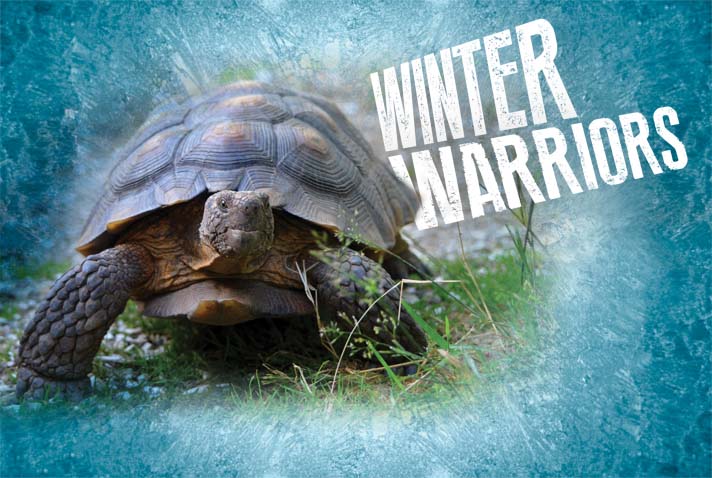
chris leone
The desert tortoise is a U.S. species that will brumate during the winter.
Tortoises are ectothermic (cold blooded) and they don’t actually hibernate, but instead enter a period of dormancy that is referred to as “brumation.” Unlike mammals, reptiles are not in a true state of sleep during this time. They enter a state of torpor to deal with unfavorable conditions by becoming less physiologically active during a decline in temperature. Because they cannot reach optimal digestive temperatures during the coolest part of the year, brumation reduces their risk of losing too much weight by remaining inactive.
Simply put, by resting, the tortoises are not burning precious calories. When a warm winter day occurs, however, they are capable of emerging from their burrows to soak up some sun and may even drink from a puddle. Mammals do not do this.
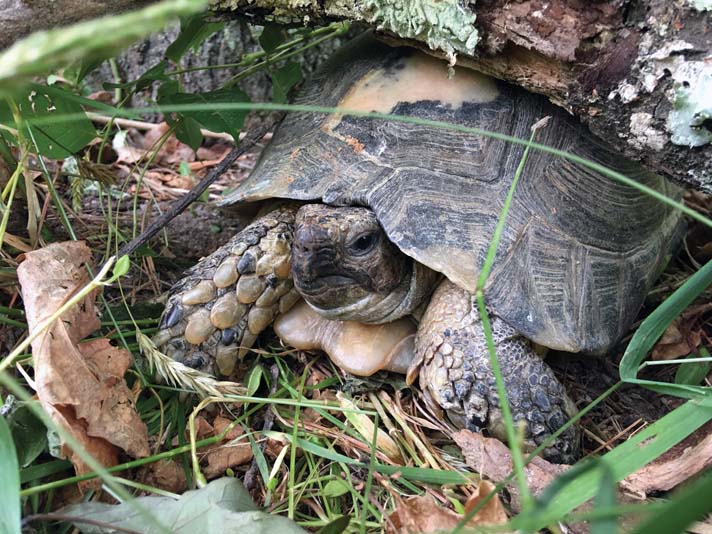
chris leone
A marginated tortoise nestles among some leaves. The first trigger for brumation is the nighttime drop in temperatures during autumn.
Only certain tortoise species can safely brumate; types that experience the same seasons we do in areas such as the northeastern U.S. Those belonging to the genus Testudo are particularly accustomed to doing so, and keepers have had success brumating them under captive conditions for years. These include the Hermann’s tortoises (Testudo hermanni ssp.), marginated tortoise (T. marginata) and some types of Greek tortoise (T. graeca ssp.), particularly the Asia Minor or “Ibera Greek” (T. g. ibera). Russian tortoises (formerly T. horsfieldii, now Agrionemys horsfieldii) also fall into the “safe-to-brumate” category, as do some American tortoises, such as the desert tortoise (Gopherus agassizii).
The majority of the world’s tortoise species are not safe to brumate. Even though many of them experience some kind of cooler portion of the year that forces them to remain somewhat inactive, they cannot handle the temperatures or length of inactivity that the previously mentioned tortoises can. It’s crucial to know what your own tortoises experience naturally in the wild, and what they are able to withstand. Otherwise, attempting to brumate a tortoise that does not normally experience brumation in nature will surely end in illness and quite likely, the tortoise’s untimely death.
Why Brumate A Tortoise?
There does not seem to be any concrete evidence that brumation is healthier for captive tortoises as opposed to keeping them awake and active throughout our winter months. However, it is something Testudo and the other tortoise species mentioned previously experience in nature, and it is only right to offer them the chance to do so in captivity. Mimicking a reptile’s natural environment in captivity has proven to be beneficial to pet herps, and most European and American tortoises respond to seasonal triggers while adhering to a fairly regular annual cycle. They become active during spring, breeding and laying eggs into summer, breeding again in fall, then slowing down and becoming dormant during the winter.
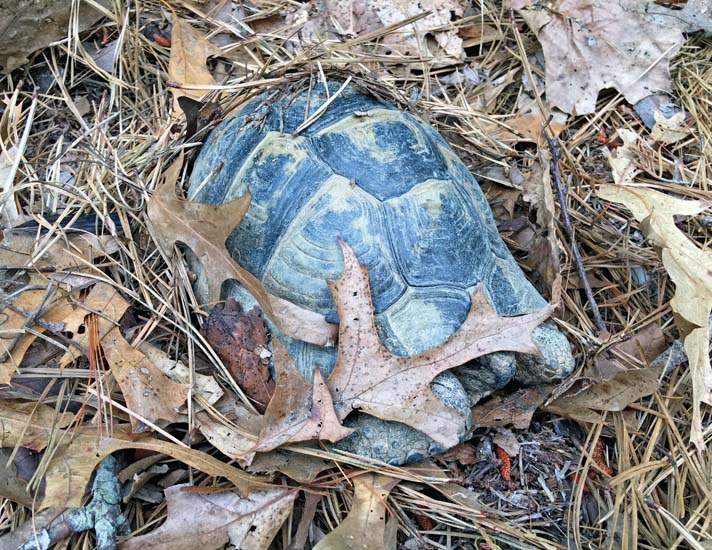
chris leone
A sleepy Greek tortoise nestles among some leaves.
Can female tortoises “burn out” or suffer from calcium deprivation if they produce excessive egg clutches yearly without a brumation phase? It’s tough to say, but surely it’s not impossible.
Brumation during the cold season may also be regarded as a time for males to become fertile and produce sperm. Without it — again, in theory — they may become sterile over time. Opinions about tortoises retaining more vibrant coloration, as they would in nature, and living longer with reduced chances of illness have also surfaced as reasons for brumation. Because tortoises are so long lived, however, it is difficult to ascertain whether they will live longer or remain healthier if allowed to brumate. Issues such as infertility are often more associated with a lack of either males or male combat within a captive group rather than the absence of brumation, but still, we should not ignore what these creatures experience in nature.
Keepers are often frightened by the notion of brumation or hibernation, and the idea of subjecting their pets to the cold may seem unthinkable. I mean, we are dealing with reptiles, and reptiles only benefit from heat, right? That theory couldn’t be any more false. In fact, various reptile species strongly benefit from experiencing cooler periods. Keepers of the Testudo species, Russian tortoises and U.S. desert tortoises may find that their tortoises benefit from brumation, and there’s no reason to be scared about making it possible as long as you go about the process properly to ensure the tortoises’ safety.
The Brumating Process For Tortoises
In nature, Hermann’s, Asia Minor (Ibera Greek), marginated, Russian and desert tortoises generally brumate from October or November to March or April, give or take a month on either end depending on exact geographical location. The annual cycle of my outdoor tortoises (in New Jersey, where I live) somewhat replicates this.
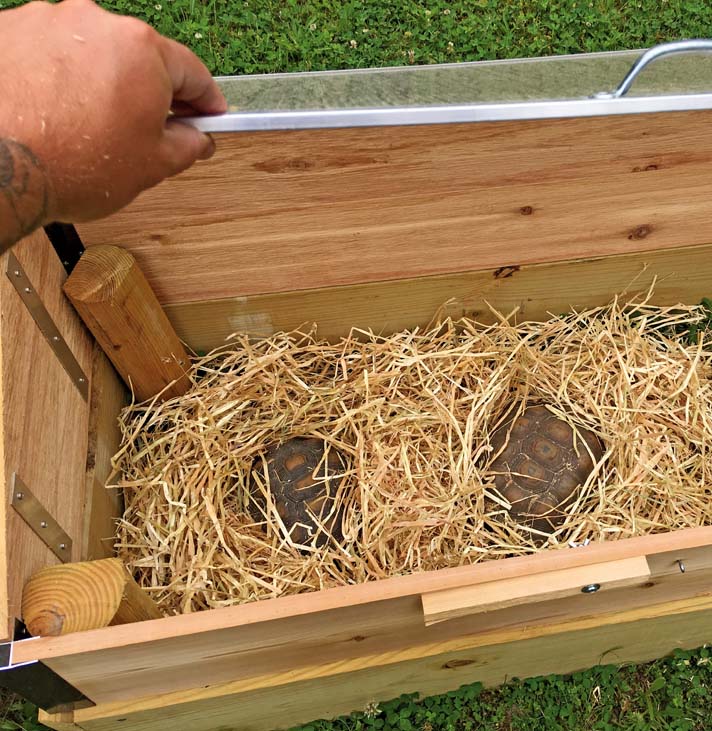
chris leone
Desert tortoises being prepared for brumation in a cold frame.
The first trigger for brumation is the autumn decrease in nighttime temperatures, even if warmer daytime temps still linger. Cool nights cause my tortoises to sense the impending winter season, and once the days start remaining cooler, the tortoises begin to exhibit a decrease in appetite.
Autumn weather in New Jersey can be unpredictable; one week may be cool and rainy while the next could include days of 75-degrees Fahrenheit or higher. During these temperature spikes, the tortoises may feed on planted vegetation inside their pens, but there will no longer be any additional feeding from us as they press on with the changing season.
As October moves forward, the tortoises will readily bask both outside in the sunlight, even on cool days, as well as inside the cold frames or greenhouses they are provided with. Depending on the location of an enclosure in our yard, we may install a 250-watt infrared brooder lamp inside a cold frame. Tortoises will congregate in numbers under it and will defecate as they empty their systems of any remaining food.
Access to water is critically important at this time, as it aids the tortoises in flushing out their digestive tracts. Forcing soaks is not something I prefer to do; if you provide them with water to drink and soak themselves, they will locate it easily.
By mid-November, consistent colder daytime temperatures cue the tortoises to dig into the substrate inside the cold frames or in another part of their outdoor pens. It is crucial to locate any tortoises that begin digging outside of the cold frame to protect them from being stuck out there when dangerous winter conditions set in. It is imperative that the tortoises are not forced to stay inside the cold frame if warm days occur, to avoid bringing them to a more active level prematurely. We have noticed that they will generally cease all activity and remain partially burrowed once daytime temperatures do not exceed 50 degrees.
Read More
Marginated Tortoise Information and Care
Paying attention to temperatures is key because warmth can promote hunger. The intermittent nibbling of vegetation here and there will not harm the animals as they prepare for winter, but a heavy consumption can result in too much food in the gut. This can then cause major health problems during dormancy.
The Container Method For Brumating A Tortoise
Because of high regional snowfall and precipitation in New Jersey, we do not brumate our tortoises outside exclusively. Two methods have worked well for us, and the same can easily be used in other parts of the U.S. where seasonal changes are experienced.
The first method is to allow the tortoises to completely cool down on their own while being subjected to the natural changes of the season outdoors, and then, once they’re inactive, moving them from their outdoor pens to finish brumation in a more controlled setting — namely, a large, plastic tub.
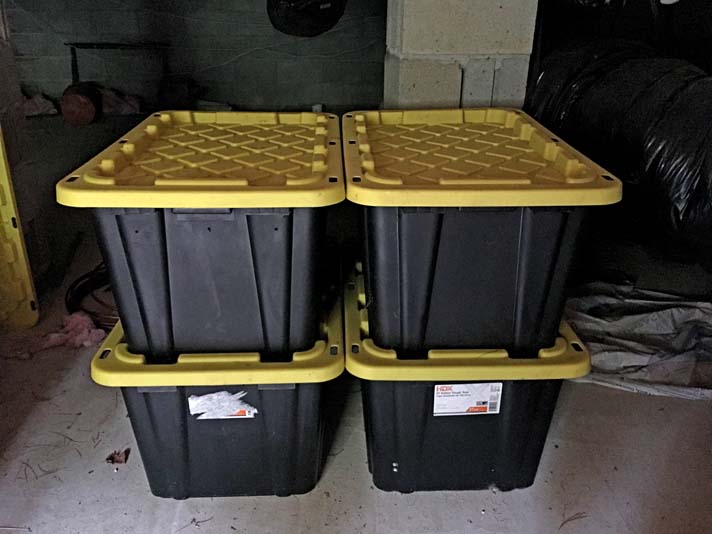
chris leone
The author brumates tortoises placed inside plastic tubs that are then stored in a cool crawlspace. When stacking, be sure to punch air holes into the sides of the containers that have others stacked on top of them.
To accomplish this, sometime in late December, after the tortoises have burrowed in and no longer move about or bask, we remove them from their pens at night and place them in large, plastic tubs that are filled halfway with a combination of 70 percent moist (not wet!) organic potting mix and 30 percent play sand. A thick layer of dry straw is placed on top of the substrate and tortoises are placed on top of that. Container lids, with air holes punched into them, are attached. Meanwhile, the tortoises usually burrow into the substrate.
The tubs are placed side by side in a crawlspace (basements can work, too) where the temperature remains between 38 and 52 degrees for the winter. There, the tortoises will sleep undisturbed inside their tubs. On relatively warm days, when the outside temperature causes a slight rise in the crawlspace temperature, tortoises may move about a little, but this does not concern us Some literature states that brumating tortoises should be checked frequently for weight loss. I find this unnecessary and invasive, as only healthy tortoises should be brumated to begin with.
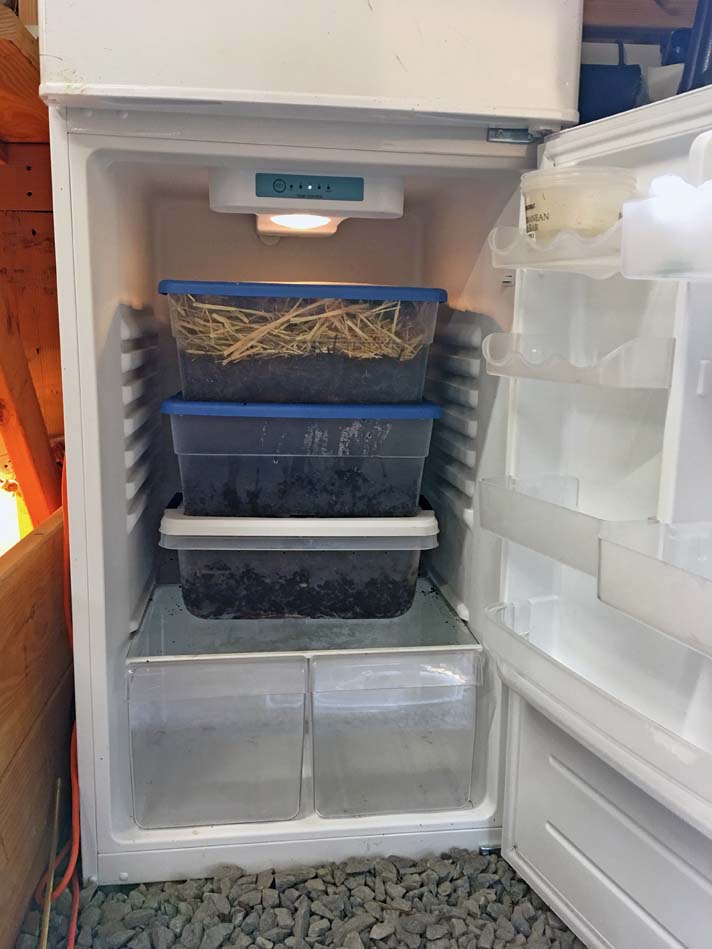
chris leone
A refrigerator allows keepers to more accurately set brumation temperatures for their tortoises.
No food is offered during the entire brumation duration, and if the substrate in their containers is properly moistened, the tortoises have no need for any additional water. Occasional checks should be made to ensure the substrate does not dry out completely.
We only physically inspect a tortoise if it has surfaced from the substrate on its own; we never dig them out. If one does emerge, we’ll check for discharge from its eyes, nose and mouth. We’ll also determine whether it has defecated unexpectedly, which it shouldn’t if the gut is properly empty. If a tortoise exhibits any of these conditions, we do not place it back into brumation and, instead, it is kept active through the winter.
For some Testudo tortoises that were more sensitive to cooling situations, we found it effective to remove them from the outdoor enclosure at the end of autumn, before December, when the other tortoises are moved to their tubs and when the true winter elements set in. These tortoises may include Greek tortoises from more arid areas in nature, such as the Mesopotamian or “golden” Greek tortoise (T. graeca terrestris), the Moroccan Greek tortoise (T. g. marokkensis) and even some strains of western Hermann’s tortoise (T. hermanni hermanni) deriving from areas like the Balearic Islands.
Allowing the tortoises to naturally cool down through autumn enables them to become semi-inactive and even inactive for a short period. They are then removed from the outdoor setting, but instead of being kept asleep in an artificial hibernaculum as described previously, these tortoises are brought inside our tortoise building. In there, they are gradually warmed and allowed to resume their normal activity patterns. They are kept in the tortoise building until the weather shapes up in April, when they are placed back outside.
How To Wake A Tortoise From Brumation
When tortoises brumate naturally outdoors, they awaken as they sense the rise in temperatures and other natural factors. When kept in a tub in a crawlspace, basement or other indoor area for artificial brumation, we have to wake them up.
Our tortoises usually remain in their brumation containers until late March or early April. Once outdoor temperatures are consistently reaching the high 50s and low 60s (usually sometime in mid to late April) during the day, even though they may still be in the high 30s or 40s at night, the tortoises are removed from the containers and placed back into their outdoor pens.
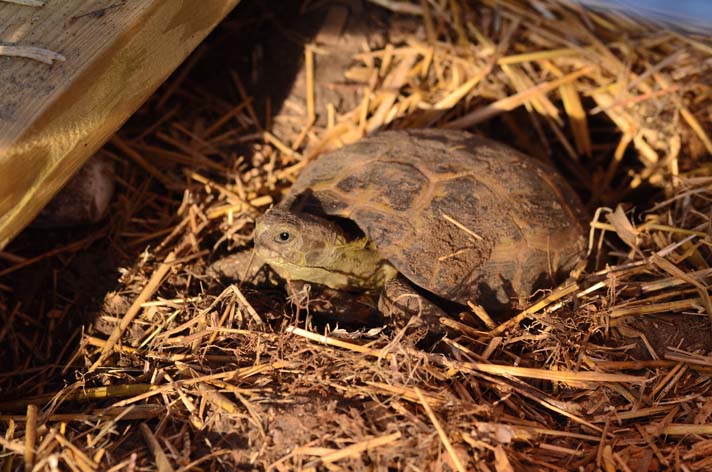
chris leone
Wakey wakey! A Russian tortoise emerges from brumation.
The reason for waking them up while temperatures are still relatively cool is to avoid shocking them and to allow them to gradually resume activity. Typically they are placed in leaf litter or inside the cold frames. This gives them the chance to freely move about if they choose to while not being stressed by being outright exposed to everything. They will dig in at night until both day and night temperatures rise. Then they will become fully active for the season, and feeding, breeding and egg laying will soon follow.
It’s worth mentioning that while it’s perfectly fine to soak tortoises after they wake up, remember that no one does this for them in nature. They seek out areas to drink on their own, and if you providing drinking bowls in the enclosure, they will surely locate them.
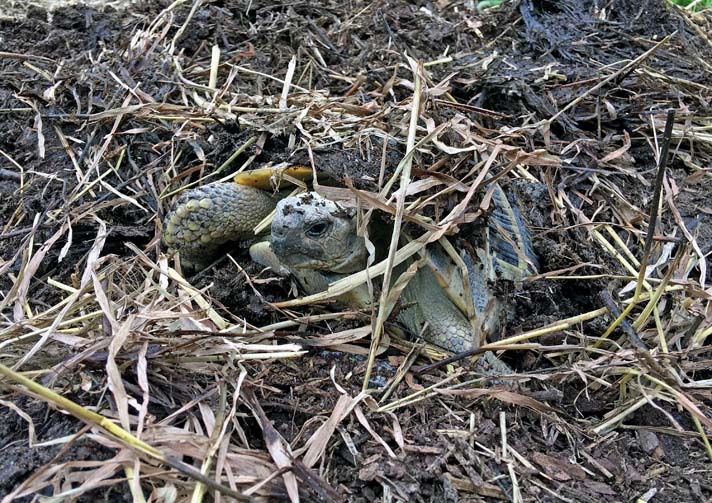
chris leone
Come spring, a Hermann’s tortoise emerges from its burrow.
Until air temperatures rise into the 70s, we leave the previously mentioned 250-watt infrared lights on 24 hours a day. When temps are in the 70s, the lamps are on only at night, and by mid-May they are usually no longer needed. By then, the tortoises are enjoying the warm season to its fullest extent.
Come early fall, the infrared lamps are once again turned on at night, mostly on sun-deprived days, so the tortoises may remain warm as they once again go about emptying their digestive tracts in preparation for the dormancy period that is once again approaching.
Brumating tortoises can be viewed as a choice, at least for now. We have quite a way to go in learning about chelonian care, and we are far from truly understanding most of it. It’s imperative to always keep in mind what these creatures experience in the natural world. This teaches us to better care for them.
Chris Leone is director of animal husbandry for theTurtleRoom and the owner of Garden State Tortoise. His work with chelonians spans more than two decades. Visit him at theTurtleRoom.com and GardenStateTortoise.com.



